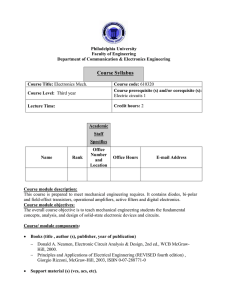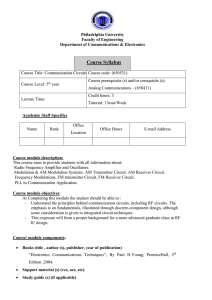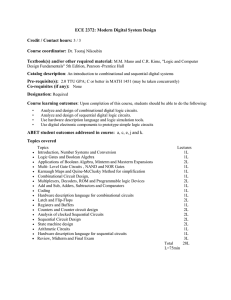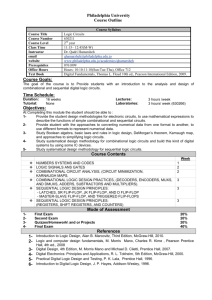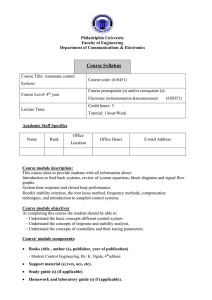Course Syllabus
advertisement
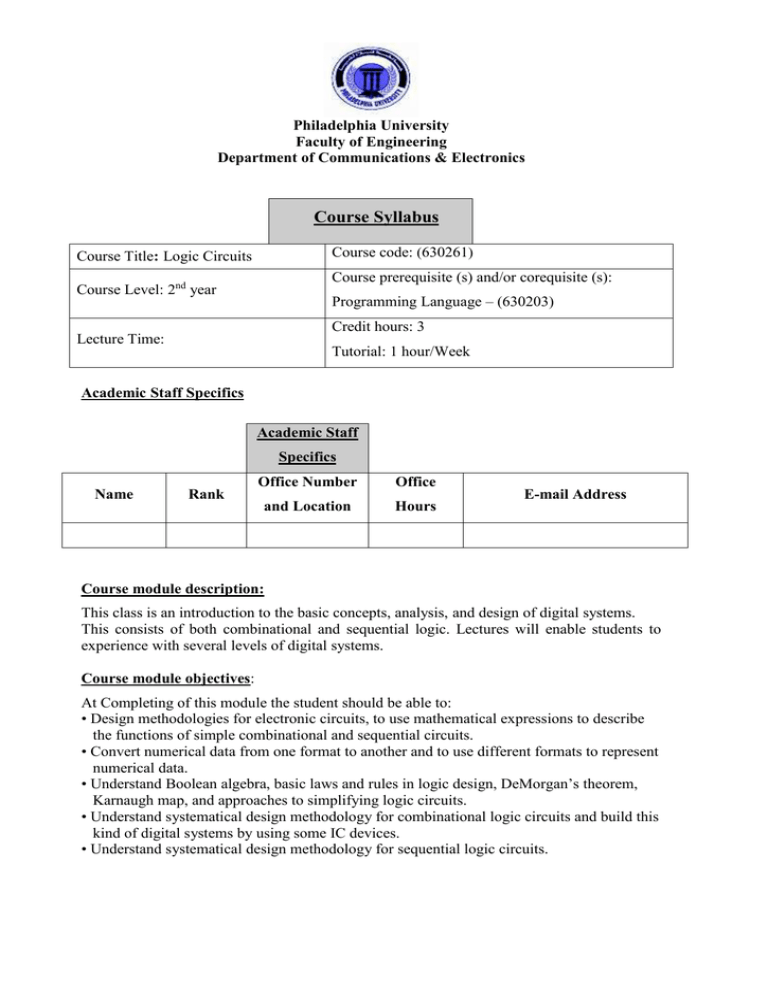
Philadelphia University Faculty of Engineering Department of Communications & Electronics Course Syllabus Course code: (630261) Course Title: Logic Circuits Course prerequisite (s) and/or corequisite (s): Course Level: 2nd year Programming Language – (630203) Credit hours: 3 Lecture Time: Tutorial: 1 hour/Week Academic Staff Specifics Academic Staff Specifics Name Rank Office Number Office and Location Hours E-mail Address Course module description: This class is an introduction to the basic concepts, analysis, and design of digital systems. This consists of both combinational and sequential logic. Lectures will enable students to experience with several levels of digital systems. Course module objectives: At Completing of this module the student should be able to: • Design methodologies for electronic circuits, to use mathematical expressions to describe the functions of simple combinational and sequential circuits. • Convert numerical data from one format to another and to use different formats to represent numerical data. • Understand Boolean algebra, basic laws and rules in logic design, DeMorgan’s theorem, Karnaugh map, and approaches to simplifying logic circuits. • Understand systematical design methodology for combinational logic circuits and build this kind of digital systems by using some IC devices. • Understand systematical design methodology for sequential logic circuits. Course/ module components: Books (title , author (s), publisher, year of publication) - (Text Book) Digital Design, 4th Edition, M. Morris Mano and Michael D. Ciletti, Prentice Hall, 2007. Support material (s) (Course website: Includes reference books and Course Notes_ Power Point Slides). http://lbadri.com/index.php?option=com_content&task=view& id=29&Itemid=33 Study guide (s) (if applicable) Homework and laboratory guide (s) if (applicable). Teaching methods: Lectures, tutorials, and problem solving. Learning Outcomes: A) Knowledge and understanding Skills: Students will obtain knowledge and understanding of: 1) Fundamental technological concepts, principles, and techniques associated with electronics and communications systems. 2) The way of thinking and how to design. C) Practical Skills: Students will acquire and develop the practical skills that should allow them to: 1) Use various laboratory equipment as diagnostic tool to detect a faults and identify a problem in electronics or/and communication system. 2) Analyze, design, evaluate, system behavior and test electronic or/and communication system using simulation or computer-based tool (engineering software tool). 3) Deal with computer hardware and use electronic and communication project. D) Practical and subject specific skills (Transferable Skills): Students will acquire and develop the key transferable skills that will enable them to: 1) Use a range of technological equipment and systems. 2) Think logically and critically. Assessment instruments: • Short reports and/ or presentations, and/ or Short research projects • Quizzes. • Home works • Final examination: 50 marks Allocation of Marks Assessment Instruments Mark First examination 15% Second examination 15% Final examination: 50 marks 50% Reports, research projects, Quizzes, Home 20% works, Projects Total 100% Documentation and Academic Honesty Submit your home work covered with a sheet containing your name, number, course title and number, and type and number of the home work (e.g. tutorial, assignment, and project). Any completed homework must be handed in to classroom. After the deadline “zero” will be awarded. You must keep a duplicate copy of your work because it may be needed while the original is being marked. You should hand in with your assignments: 1- A printed listing of your test programs (if any). 2- A brief report to explain your findings. 3- Your solution of questions. For the research report, you are required to write a report similar to a research paper. It should include: o Abstract: It describes the main synopsis of your paper. o Introduction: It provides background information necessary to understand the research and getting readers interested in your subject. The introduction is where you put your problem in context and is likely where the bulk of your sources will appear. o Methods (Algorithms and Implementation): Describe your methods here. Summarize the algorithms generally, highlight features relevant to your project, and refer readers to your references for further details. o Results and Discussion (Benchmarking and Analysis): This section is the most important part of your paper. It is here that you demonstrate the work you have accomplished on this project and explain its significance. The quality of your analysis will impact your final grade more than any other component on the paper. You should therefore plan to spend the bulk of your project time not just gathering data, but determining what it ultimately means and deciding how best to showcase these findings. o Conclusion: The conclusion should give your reader the points to “take home” from your paper. It should state clearly what your results demonstrate about the problem you were tackling in the paper. It should also generalize your findings, putting them into a useful context that can be built upon. All generalizations should be supported by your data, however; the discussion should prove these points, so that when the reader gets to the conclusion, the statements are logical and seem self-evident. o Bibliography: Refer to any reference that you used in your assignment. Citations in the body of the paper should refer to a bibliography at the end of the paper. Protection by Copyright 1. Coursework, laboratory exercises, reports, and essays submitted for assessment must be your own work, unless in the case of group projects a joint effort is expected and is indicated as such. 2. Use of quotations or data from the work of others is entirely acceptable, and is often very valuable provided that the source of the quotation or data is given. Failure to provide a source or put quotation marks around material that is taken from elsewhere gives the appearance that the comments are ostensibly your own. When quoting word-for-word from the work of another person quotation marks or indenting (setting the quotation in from the margin) must be used and the source of the quoted material must be acknowledged. 3. Sources of quotations used should be listed in full in a bibliography at the end of your piece of work. Avoiding Plagiarism. Unacknowledged direct copying from the work of another person, or the close paraphrasing of somebody else's work, is called plagiarism and is 1. a serious offence, equated with cheating in examinations. This applies to copying both from other students' work and from published sources such as books, reports or journal articles. 2. Paraphrasing, when the original statement is still identifiable and has no acknowledgement, is plagiarism. A close paraphrase of another person's work must have an acknowledgement to the source. It is not acceptable for you to put together unacknowledged passages from the same or from different sources linking these together with a few words or sentences of your own and changing a few words from the original text: this is regarded as over-dependence on other sources, which is a form of plagiarism. 3. Direct quotations from an earlier piece of your own work, if not attributed, suggest that your work is original, when in fact it is not. The direct copying of one's own writings qualifies as plagiarism if the fact that the work has been or is to be presented elsewhere is not acknowledged. 4. Plagiarism is a serious offence and will always result in imposition of a penalty. In deciding upon the penalty the Department will take into account factors such as the year of study, the extent and proportion of the work that has been plagiarized, and the apparent intent of the student. The penalties that can be imposed range from a minimum of a zero mark for the work (without allowing resubmission) through caution to disciplinary measures (such as suspension or expulsion). Course/module academic calendar week (1) (2) (3) (4) (5) (6) (7) First exam (8) (9) (10) (11) Basic and support material to be covered Course Overview Introduction to Digital Systems. Number Systems and Conversions Boolean Algebra and Logic Gates Minimization Methods and Don’t care conditions Representation and implementation of Boolean circuits using other logic gates. Tutorials, review and study guide of first exam material Analysis Procedure of combinational circuits Combinational Circuits design, BCD Display Adder and Subtractor, Magnitude comparators, Multiplexers, Encoders, and Decoders. Tutorials, review and Homework/reports and their due dates Assingment1 Week 4 Assingment2 Week 5 Assingment3 Week 6 Assingment4 Week 9 Assingment5 Week 10 Assingment6 (12) Second examination (13) (14) (15) Specimen examination (Optional) (16) Final Examination study guide of second exam material Week 12 Sequential Circuits: Latches and Flip flops Assingment7 Week 13 Analyzing Sequential Circuits, Finite State Machine Design Procedure. State Reduction and Assignment Shift Registers, Counters, And Timing Analysis. Tutorials, review and study guide of final exam material Assingment8 Week 14 Assingment9 Week 15 Specimen examination (Optional) --- Expected workload: On average students need to spend 2 hours of study and preparation for each 50-minute lecture/tutorial. Attendance policy: Absence from lectures and/or tutorials shall not exceed 15%. Students who exceed the 15% limit without a medical or emergency excuse acceptable to and approved by the Dean of the relevant college/faculty shall not be allowed to take the final examination and shall receive a mark of zero for the course. If the excuse is approved by the Dean, the student shall be considered to have withdrawn from the course. Course references Books: 1) Practical Digital Logic Design and Testing, P. K. Lala, Prentice Hall, 1996. 2) Introduction to Digital Logic Design, J. P. Hayes, Addison-Wesley, 1996. 3) Digital Electronics: Principles and Applications, R. L. Tokheim, 5th Edition, McGrawHill, 2000. Web sites: http://lbadri.com http://www.digikey.com http://www.edaboard.com/forums.html
